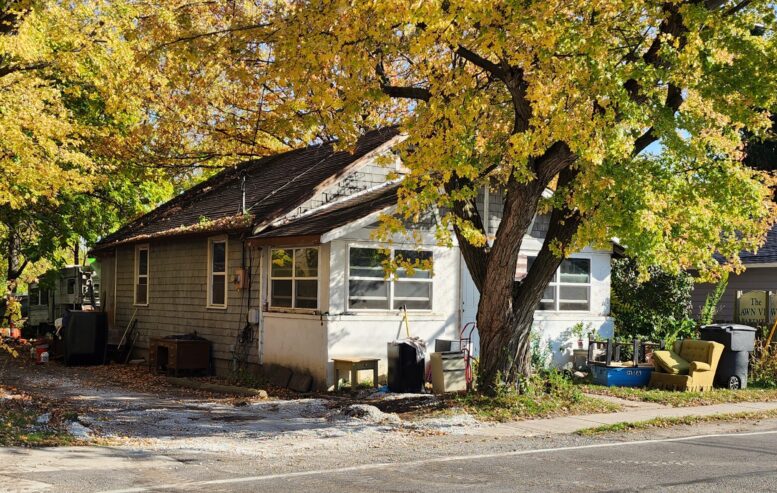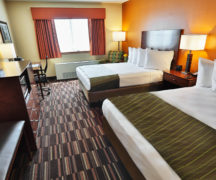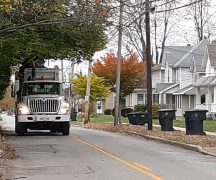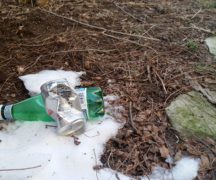By JAN LARSON McLAUGHLIN
BG Independent News
The City of Bowling Green wants to crack down on properties that bring blight to their neighborhoods – broadening the scope beyond rental units to also include owner-occupied homes and businesses.
To do that, City Council is considering changes that would sharpen the teeth of exterior property maintenance regulations, speed up remedies to problems, and stiffen penalties for landowners who don’t comply.
Mayor Mike Aspacher said the changes would allow the city to enforce code violations as criminal, not just civil infringements.
The changes would also try to streamline the system, which is currently bogged down with requirements for multiple notices for the same infractions.
“We’re trying to recognize ways we can speed up and more effectively enforce those laws,” Municipal Administrator Lori Tretter said.
The changes remove any confusion over who is responsible for the upkeep of structures and the properties they sit on.
“Homeowners ultimately have the responsibility of maintaining their homes,” Aspacher said.
Aspacher and Tretter said the city administration has been assessing all of its exterior property maintenance enforcement resources. Those include personnel in city offices of code enforcement, community development, the law director, the police division, as well as county building inspection and the health department.
The city is discussing the additional tools that may be needed to make the system work better.
“This is an effort to be more proactive,” with nuisance or dangerous situations caused by lack of exterior property maintenance, Aspacher said.
It has not yet been decided if the toughening of property maintenance codes will include additional staff, and if the system will work purely on citizen reports or if city personnel will proactively look for problem properties.
Ultimately, the city would like landowners to correct problems without penalties being enforced.
“We try to be empathetic in working with people,” the mayor said. “We try to work for compliance rather than bringing the hammer down.”
But the latest proposed changes will keep the hammer handy if needed.
In the case of a public nuisance or violation of this code, a written notice from the city’s property maintenance officer will be directed to the property owner. The notice will outline the violations, corrective action that must be taken, and a reasonable time (not to exceed 45 days) to correct the problem.
If the owner fails to comply with a notice from the city, the property maintenance officer may request the city’s law director to institute a legal action to compel compliance.
Anyone violating any provision of this chapter is guilty of a minor misdemeanor, according to the regulations.
Anyone violating subsequent offenses in this chapter will be guilty of a misdemeanor of the fourth degree. Each violation of a section of this code shall constitute a separate and distinct violation.
City Council heard the first reading of proposed changes last week.
Weeds and broken down cars
On the table are ordinance amendments that would permit quicker action on inoperable vehicles on properties, noxious weeds and exterior maintenance violations.
Instead of posting multiple notices in newspapers for owners of broken down vehicles, and sending notices each time noxious weeds get out of control, the process will be streamlined.
For example, under the existing system, the city is often posting noxious weed notices at the same properties throughout the growing season. If the changes are adopted, a property owner gets one written notice, then is considered notified about noxious weed and tall grass rules.
Exterior building issues
Council is also considering improving exterior property maintenance in Bowling Green with the addition of Chapter 159 to city ordinances.
The regulations are intended to protect the public health, safety and welfare of city residents by:
- Preventing property deterioration and by establishing minimum standards governing the maintenance, appearance and conditions of all residential and non-residential premises.
- Fixing certain responsibilities and duties for owners and occupants.
- Establishing procedures for the inspection of residential and nonresidential premises.
- Fixing penalties for violations of this code.
The code changes would be applicable to every residential and nonresidential building and the premises on which they are situated in Bowling Green. All sites will be required to comply with the regulations, regardless of when built or altered, and irrespective of any permits granted prior to the new regulations.
Owners responsible
The change establishes owner and occupant responsibilities for buildings.
Property owners would have all the duties and responsibilities as prescribed in the code – and will not be entitled to defend against any charge of violations by claiming the occupants share in responsibilities.
The new regulations would require owners to:
- Keep the exterior of all premises and every structure including walls, roofs, cornices, chimneys, drains, towers, porches, landings, fire escapes, stairs, store fronts, signs, windows, doors, awnings, and marquees in good repair.
- Keep all surfaces painted or protected with other coating or material where necessary for the purposes of preservation and avoiding a blighting influence on adjoining properties.
- Maintain all surfaces free of broken glass, loose shingles, crumbling stone or brick, peeling paint or other conditions reflective of deterioration or inadequate maintenance, so the property may be preserved safely, fire hazards eliminated, and adjoining properties and the neighborhood protected from blighting influences.
Preventing eyesores
The overall premises, the exterior of dwelling structures, and the condition of accessory structures would also be required to be maintained so that the appearance of the premises would reflect a level of maintenance in keeping with the standard set forth in this code. The goal is to make sure the appearance of the premises and structures will not constitute a blighting factor for the adjoining property owners nor an element leading to progressive deterioration and downgrading of the immediate neighborhood.
Maintenance obligations would include:
- Storage of commercial and industrial material. There shall not be stored or used at a location visible from the sidewalk, street, or other public area, equipment and materials relating to commercial or industrial uses, unless permitted under the zoning ordinance from the premises.
- Landscaping. Lawns, hedges and bushes shall not be overgrown and unsightly where exposed to public view, and contributes to a blighting factor which depreciates any adjoining property.
- Removal of all miscellaneous rubbish. All yards, courts or lots shall be kept free of unsightly refuse/rubbish which may cause a fire hazard or act as a breeding place for vermin or insects.
Any dwelling structure or secondary structure whose exterior surface is bare, deteriorated, ramshackle, tumbledown, decaying, disintegrating, or in poor repair must be repaired or razed.
In addition:
- All buckled, rotted or decayed walls, doors, windows, porches, floors, steps trim, railings and their missing members, must be replaced and put in good condition.
- The structure shall be maintained free of broken windows, crumbling stone or brick, or other conditions reflective of deterioration to the end that the property itself may be preserved, safety and fire hazards eliminated, so that health, safety and welfare of the public is not threatened.
Business buildings
The regulations also set standards for the maintenance of exteriors for nonresidential buildings and secondary structures.
The exterior of all nonresidential premises and the condition of accessory structures shall be maintained in keeping with the standards of the immediate neighborhood so that the appearance of the premises and structures shall not constitute a blighting factor on the adjoining property owner nor an element leading to the progressive deterioration and downgrading of the immediate neighborhood including the following:
- Landscaping. Lawns, hedges and bushes shall not be overgrown and unsightly where exposed to the public view and where the same constitute a blighting factor which depreciates any adjoining property. All yards, courts or lots shall be kept free of rubbish which may cause a fire hazard or may act as a breeding place for vermin or insects.
- Signs. All permanent signs exposed to public view shall be maintained in good repair. Any signs which have weathered or are faded, have peeling paint shall be removed or fixed.
- Storefronts. All storefronts shall be kept in good repair, painted where required, and shall not constitute a safety hazard or a nuisance. Any cornice visible above a storefront shall be kept painted, when required, and in good repair.
- Awnings and marquees. Any awning or marquee which extends over any street, sidewalk, or other portion of the premises shall be maintained in good repair, and shall not create a nuisance or a safety hazard.
All parts of the premises shall be maintained so as to prevent infestation by insects, termites and rodents.





